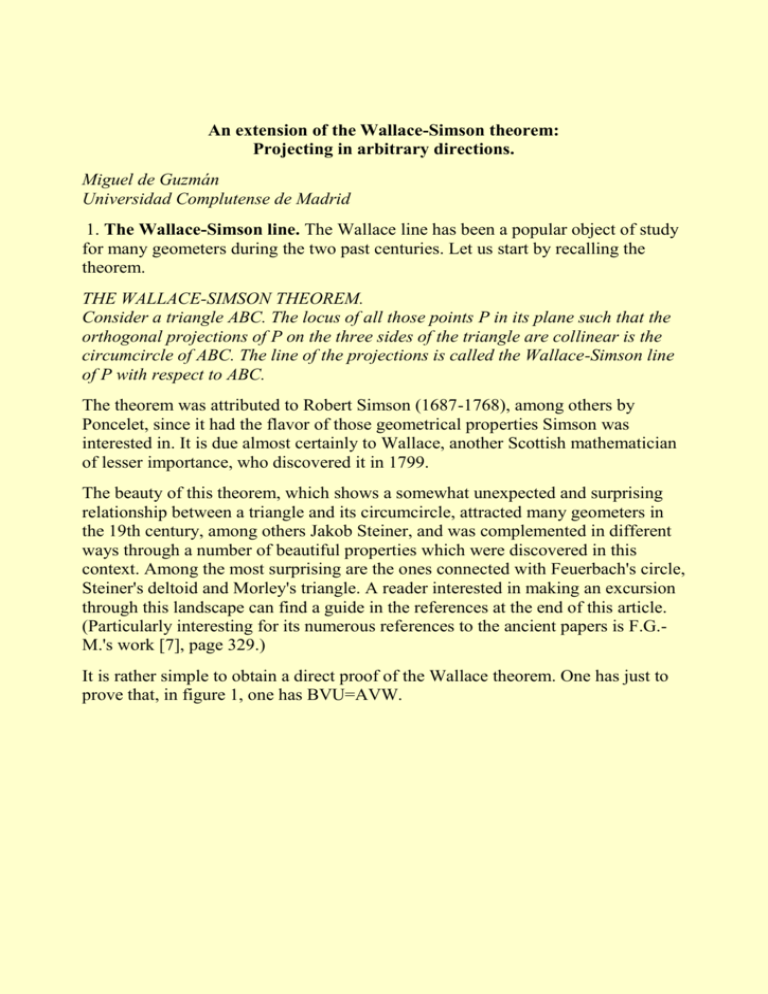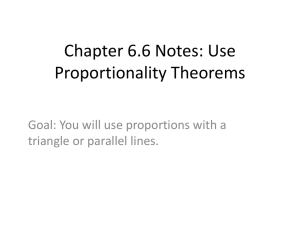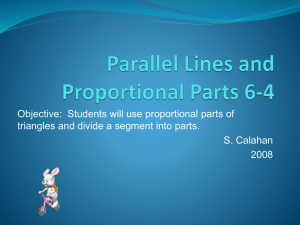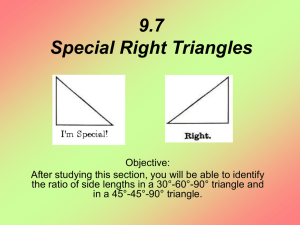Wallace-Simson-Monthly - Facultad de Ciencias Matemáticas
advertisement

An extension of the Wallace-Simson theorem: Projecting in arbitrary directions. Miguel de Guzmán Universidad Complutense de Madrid 1. The Wallace-Simson line. The Wallace line has been a popular object of study for many geometers during the two past centuries. Let us start by recalling the theorem. THE WALLACE-SIMSON THEOREM. Consider a triangle ABC. The locus of all those points P in its plane such that the orthogonal projections of P on the three sides of the triangle are collinear is the circumcircle of ABC. The line of the projections is called the Wallace-Simson line of P with respect to ABC. The theorem was attributed to Robert Simson (1687-1768), among others by Poncelet, since it had the flavor of those geometrical properties Simson was interested in. It is due almost certainly to Wallace, another Scottish mathematician of lesser importance, who discovered it in 1799. The beauty of this theorem, which shows a somewhat unexpected and surprising relationship between a triangle and its circumcircle, attracted many geometers in the 19th century, among others Jakob Steiner, and was complemented in different ways through a number of beautiful properties which were discovered in this context. Among the most surprising are the ones connected with Feuerbach's circle, Steiner's deltoid and Morley's triangle. A reader interested in making an excursion through this landscape can find a guide in the references at the end of this article. (Particularly interesting for its numerous references to the ancient papers is F.G.M.'s work [7], page 329.) It is rather simple to obtain a direct proof of the Wallace theorem. One has just to prove that, in figure 1, one has BVU=AVW. Figure 1 Observing that quadrilateral PVUB is cyclic because of the right angles at U and V one gets BVU=BPU=90º-PBU=90º-PBC. In the same way PVAW is also cyclic and therefore AVW=APW=90º-PAW=90º-(180º-PAC)=PAC-90º. But it is quite clear that PAC-90º=90º-PBC since the angles at A and B are supplementary in cyclic quadrilateral PBCA, and so BVU=AVW, which shows that U,V, and W are collinear. 2. An extension of the theorem. The goal of this note is to present a generalization of the Wallace theorem along a direction which, in spite of being strikingly simple, I have never seen explored up to now. I first state the theorem and discuss its proof and then present some nice exercises that can be proposed and solved in a simple way by means of the tools that arise in this context. Theorem. Consider a triangle ABC. Let us call a,b,c, the corresponding sides opposite the vertices. We fix three projection directions , , not all three equal, and such that is not parallel to side a, is not parallel to side b and is not parallel to side c. Take an arbitrary point P in the plane of ABC and project it on a along obtaining U, on b along obtaining V and on c along obtaining W. Fix a real number k and an orientation in the plane in order to give a sign to the areas of the triangles we consider. Then the locus of all points P such that the oriented triangle UVW has area k is a conic C(k). It is clear that C(0) always goes through the three vertices A,B,C (for example, with P at A, V and W are also at A). The conic C(k) can, of course, degenerate in different ways, as we shall see. When k varies (with fixed , ), the family C(k) is always a family of conics with the same points at infinity. Furthermore, if one of them has a center, all others have the same center and are homothetical to each other (except the possible degenerate elements of the family C(k)), the homothecy center being the common center of all such conics. If none has a center, then they are all translations of the same parabola along the direction of its axis. The construction, with straightedge and compass, of the common center (when it does exist) and of the axes and asymptotes of the conics of the family C(k) is easily done once one knows A,B,C and the projection directions , . Proof. The theorem is one of those results whose only difficulty consists in arriving at its statement, since the easy analytical proof we develop could be left as an exercise to the reader. Let us begin by fixing an arbitrary cartesian system of coordinates and an orientation to give a sign to the areas of the triangles. If the point P has coordinates (x,y) and we denote by a,b,g three vectors that correspond to the given projection directions, it is clear that the points U,V,W have as coordinates, respectively, (u1(x,y),u2(x,y)), (v1(x,y),v2(x,y)), (w1(x,y),w2(x,y)) where each of these functions is a linear function in x, y, with coefficients which only depend on the parameters (already fixed) that determine A, B, C, , , in our coordinate system. The area of the triangle UVW is given by half the value of the determinant of the matrix Therefore the equation of the locus is of the form mx2+ny2+2pxy+2qx+2ry+s=2k where m,n,p,q,r,s depend only on the fixed entities A, B, C, , . This shows that C(k) is a conic and that, when k varies, C(k) is a family of conics whose points at infinity are the same, since they are determined by mx2+ny2+2pxy=0. The last equation cannot degenerate, i.e., m, n, p cannot be 0 simultaneously. In fact, in that case C(0) would have as equation 2qx+2ry+s=0. If one of the coefficients q, r is not zero, then C(0) is a straight line, which is false, since A, B, C are points of C(0). If q=r=0 then the equation of C(0) is s=0. Therefore, if s is not 0, C(0) is empty, which is again false. If s=0 then C(0)=R2, which easily implies that all three directions , are the same; this was excluded from the beginning. Therefore, we have that C(k) is a family of conics with the same points at infinity as anounced in the statement of the theorem. If we take as the origin an arbitrary point O and as coordinate axes the two (always real) bisectors of the angles formed by the lines joining O with the points at infinity, then the equation above takes the form mx2+ny2+2qx+2ry+s=2k (where m,n,q,r,s, of course, need not be the same as before). If for some k the conic C(k) has a point Z as center and we take Z as origin and as coordinate axes the axes of the conic (the two bisectors of the angle obtained by joining Z to the two points at infinity), then the equation takes the form mx2+ny2+s=2k with m,n,s depending only, as before, on A, B, C, which makes plain the simple structure of the family C(k). All, except for s=2k, are concentric and homothetic with respect to Z. For s=2k the conic C(k) degenerates and becomes either a pair of real lines (which can coincide) or a pair of imaginary lines that intersect at Z. If in the previous equation it happens, for example, that m=0 then the equation of C(k) would be ny2+s=2k, which is, for each k, a pair of parallel lines, real or complex according to the value of k; this pair of lines becomes one double real line if s=2k. It is clear, in this case, that any point of such a double line is a center of symmetry of each C(k). If no C(k) has a center, then in the equation mx2+ny2+2qx+2ry+s=2k we have either m=0 or n=0. Assume n=0. Then mx2+2qx+2ry+s=2k and if we make the change x=X-q/m (i.e., a translation of the y axis) we obtain mX2+2ry+t=2k with m,r,t depending only, as before, on A, B, C,, . The coefficient r cannot be null, since if r=0 we would have mX2+t=2k, and this is, for each k, a pair of parallel lines and thus has a center. Therefore, r is not null and so C(k) is, in this case, a family of parabolas which are all obtained as translations of one of them in the direction of its axis. Construction, with compass and straightedge, of the center, axes and asymptotes of C(k). Here we indicate a practical construction for the main elements of the conics C(k). According to the previous part of the theorem it is sufficient to find these elements for C(0), of which we already know three points A,B,C. If two of the projection directions coincide, for example , it is easy to show in a direct way that C(0) is the line BC together with the line through A in the direction , independently of the direction . It is also easy to show that the fact that two of the projection directions coincide is a necessary and sufficient condition for the degeneration of the conic C(0) into two lines (one of them is the line containing one of the sides of the triangle and the other is the line through the opposite vertex in the same direction as the two coinciding ones). It is then quite clear that, if does not coincide with the direction of the side BC, then C(k), with k different from 0, is a family of hyperbolas having these two lines as asymptotes that are homothetic to each other with respect to their common center, the intersection of those two lines. When has the same direction as the side BC, each C(k) is a pair of parallel lines (that coincide for k=1/2) and parallel to those that constitute C(0). Thus, we have determined the main elements of C(k) in the case that C(0) degenerates. If no pair of projection directions coincide, then C(0) is a non-degenerate conic for which we already know three points. Another three are easily determined in the following way: Figure 2 Through B we draw a line parallell to and through C a line parallel to ; this makes V=C and W=B and UVW degenerates; it is clear that the intersection R belongs to C(0). Through C we draw a line parallell to and through A a line parallel to ; similarly the intersection S belongs to C(0). Through A we draw a line parallell to and through B a line parallel to ; the intersection T belongs to C(0). We thus obtain a hexagon ATBRCS whose vertices are in C(0) and such that its opposite sides are parallel. It is clear that the midpoints of the sides of a pair of opposite sides are on a diameter of C(0). We thus obtain the center of C(0) (when it does exist) as intersection of these three diameters, DG, EH, FI (see figure 2). When the center does not exist we obtain at least the direction of the axis of the parabola C(0). Assume for the moment that there is a center as indicated in figure 2. Since we already have three pairs of conjugate diameters, the construction, with compass and straightedge, of the common asymptotes and axes of all conics C(k) is a well known exercise. For the determination of the vertex of the parabola C(0) when the center does not exist, we proceed as follows. Through A we draw a line perpendicular to the direction of the axis, which we already know. We determine its intersection A' with the parabola; the bisector line of AA' is the axis of C(0). The intersection of this line with the parabola gives us the vertex. The parabolas C(k) are the translations of C(0) in the direction of its axis. 3. Some interesting exercises related to the theorem. The theorem just proved suggests many interesting exercises which are solved easily with the elements we have used above. Here are a few with some indications of the way to solve them. Fix a triangle ABC. 1. Find necessary and sufficient conditions on the projection directions in order that C(0) and so C(k) are circles. (Of course, C(0) will be the circumcircle and all C(k) will be concentric to it.) (Hint: Consider the inscribed hexagon in C(0) that we have used in the construction of the main elements of C(0). The orthogonal projections to the sides (the Wallace theorem) are not the only possibilities in order to get circles.) 2. Determine necessary and sufficient conditions on the projection directions in order that the conics C(k) are equilateral hyperbolas. (Hint: Remember that a necessary and sufficient condition in order that a conic that goes through three points A,B,C, is an equilateral hyperbola is that it also goes through the orthocenter of ABC.) 3. For two different projection directions, determine a third projection so that the C(k) are equilateral hyperbolas. (Hint: See the hint for the previous exercise.) 4. Given three directions find, if possible, a point F such that the triangle MNP with vertices at the projections of F on the sides a,b,c in the directions is of maximum or minimum area. (Hint: Consider the equation of the conic C(k) with respect to its axes.) 5. Given a non-degenerate conic C and the triangle ABC inscribed in it, determine three directions such that C is the conic C(0) for ABC and the three given directions. (Hint: Remember the hexagon inscribed in the conic that we have used in the construction of the elements of C(0).) 6. Assume triangle ABC has area S and the radius of its circumscribed circle G is R. We draw a circle K concentric with G and with radius r. From a point P of K we draw its projections U,V,W on the sides of ABC. Determine, as a function of S, R and r, the area of the triangle UVW. (Hint: The same as in Exercise 4. Answer: Area(UVW)=(S/4)(1-r2/R2), having selected the appropriate orientation so that the triangle UVW has positive area when r<R.) REFERENCES 1. H.F. Baker, An Introduction to Plane Geometry, Cambridge U. Press, London, 1963. 2. J.H. Butchart, The Deltoid Regarded as the Envelope of Simson Lines, Amer. Math. Monthly 46 (1939) 85-86. 3. Shang-Ching Chou, Proving Elementary Geometry Theorems Using Wu's Algorithm, Contemporary Mathematics 29 (1984), 243-286. 4. H.S.M. Coxeter, Introduction to Geometry, John Wiley, New York, 1969. 5. H.S.M. Coxeter and S.L. Greitzer, Geometry Revisited, Mathematical Association of America, 1967. 6. H. Dörrie, 100 Great Problems of Elementary Mathematics. Their History and Solution, Dover, New York, 1965. 7. F. G.-M., Exercises de Géométrie, Maison, Tours, 1912. 8. B.C. Patterson, The Triangle: its Deltoids and Foliates, Amer. Math. Monthly 47 (1940), 11-18. 9. O.J. Ramler, The Orthopole Loci of Some One-Parameter Systems of Lines Referred to a Fixed Triangle, Amer. Math. Monthly 37 (1930), 130-136. 10. C.E. Van Horn, The Simson Quartic of a Triangle, Amer. Math. Monthly 45 (1938), 434-437. 11. D. Wells, The Penguin Dictionary of Curious and Interesting Geometry, Penguin, London, 1991. Miguel de Guzmán Facultad de Matemáticas Universidad Complutense de Madrid 28040 Madrid, Spain mdeguzman@bitmailer.net







